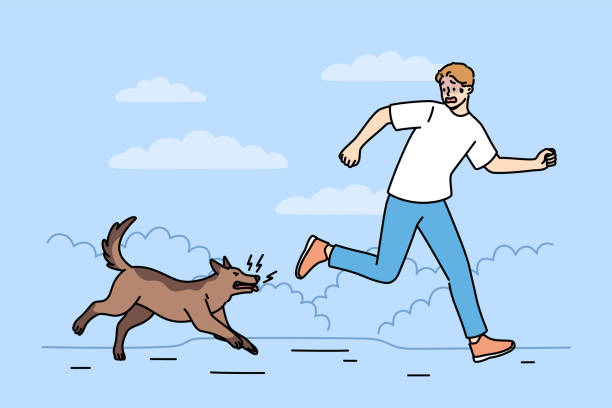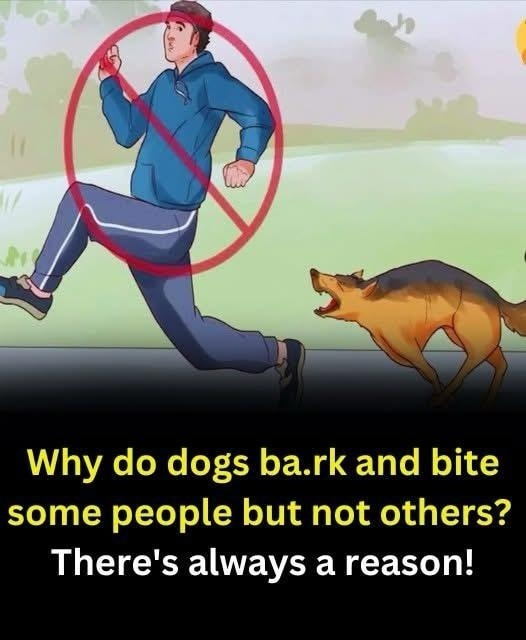A Sudden Chase: The Moment We All Recognize
You’re walking down a quiet street when you hear it — the sharp bark, the quick thud of paws against pavement. Your heart races as a dog bursts from a gate and rushes toward you. For a moment, everything slows down: the air thick with tension, the dog’s eyes fixed on you, and you wonder — why is it chasing me?
It’s a scene familiar to almost everyone. Whether it’s a playful puppy or a territorial guard dog, dogs have a deep-rooted instinct to chase. To us, it might seem aggressive or unpredictable. But to a dog, the act of chasing has centuries of instinct, emotion, and even social meaning behind it.

The Ancient Instinct: Predators Who Learned to Protect
Long before dogs became our companions, their ancestors — wolves — relied on chasing to survive. Movement triggered a hunting response. When something ran, wolves pursued it. That behavior was encoded into their biology: the thrill of pursuit, the focus of the hunt, the satisfaction of catching what moved.
Over thousands of years, as humans domesticated wolves into dogs, that instinct didn’t disappear — it simply evolved. Instead of hunting prey, dogs began chasing balls, sticks, and running humans as a form of instinctive play. Animal behaviorists often describe it as a “predatory sequence” — see, stalk, chase, grab, and release.
Even the most gentle breeds carry fragments of that ancient drive. Herding dogs, for instance, like Border Collies or Australian Shepherds, may chase people on bicycles or joggers because movement triggers their instinct to control and organize a group — just as they would with sheep.

Territory and Protection: When Chasing Becomes a Guarding Reflex
For many dogs, chasing people isn’t about aggression — it’s about protection. Dogs are highly territorial animals. Their home, yard, or even the path they often walk with their owner becomes a space they feel responsible for.
When a stranger enters that space, the dog’s body reacts instantly. The hair on their back may stand, their ears perk, and their bark becomes sharp and rhythmic. These signals are warnings — not declarations of attack. It’s the dog’s way of saying, “This is my area. Please keep your distance.”
Some dogs will stop at barking; others will chase until the perceived intruder leaves. To them, the chase is successful when the person moves away — reinforcing the idea that their protective behavior “worked.”
The Role of Scent and the Mystery of Human Smell
Humans might not notice it, but every person carries a unique scent signature, shaped by diet, hormones, and even emotions. Dogs, with up to 300 million olfactory receptors, interpret these scents like reading a story.
When they encounter a person whose scent feels unfamiliar or unsettling, their instincts kick in. They might bark or chase not out of anger, but confusion — trying to understand whether this new presence poses a threat.
Interestingly, studies show that dogs can distinguish between humans who are fearful and those who are calm based solely on body odor. A nervous person’s scent can activate a dog’s defensive or protective instincts, which may explain why anxious joggers sometimes become the unexpected targets of canine chases.

Fear, Memory, and Past Experiences
Just like humans, dogs carry emotional memories. A dog that once faced cruelty or neglect from a human may generalize that fear to strangers. When someone new appears, the dog’s body recalls past stress — the racing heartbeat, the need to flee or fight.
Animal psychologists note that fear-based chasing is often accompanied by high-pitched barking, tail tucked low, and lunging without direct contact. It’s less about aggression and more about creating distance between themselves and what they perceive as danger.
In contrast, confident dogs with positive early socialization tend to remain curious rather than reactive. They may approach new people with cautious optimism, sniffing first before deciding how to respond.

Movement Triggers: Why Running Makes It Worse
Here’s an important truth: dogs are visual creatures of motion. When something moves quickly — like a jogger, a cyclist, or even a running child — it automatically activates their chase instinct. It’s not personal; it’s biology.
To a dog, fast movement equals prey fleeing. Even well-trained dogs can momentarily lose focus when something dashes past. This is why experts often advise that when approached by an unknown dog, don’t run. Standing still, avoiding direct eye contact, and speaking softly can deactivate that instinctual chase drive.
Body Language and Miscommunication
Dogs communicate largely through body language. What humans consider friendly gestures — like waving hands, direct eye contact, or smiling with exposed teeth — can sometimes be misinterpreted by dogs.
For example:
-
Direct staring can feel like a challenge.
-
Sudden movements can signal threat or prey.
-
High-pitched voices may sound like distress calls.
A dog chasing a person might be responding to these subtle cues rather than any intention to harm. In many cases, they’re simply confused or overstimulated by mixed signals.

Breed Tendencies and Energy Levels
Not all dogs chase for the same reasons. Some breeds are hardwired for pursuit:
-
Herding breeds chase to control movement.
-
Sighthounds (like Greyhounds or Whippets) chase for speed and excitement.
-
Guard breeds chase to protect and warn.
-
Retrievers chase for fun — to fetch and return.
High-energy dogs need regular outlets for their instincts. Without proper exercise or mental stimulation, their natural drive to chase can spill into everyday life — targeting delivery workers, joggers, or even passing cars.
Human Cues: How We Accidentally Encourage Chasing
Sometimes, people unintentionally reinforce chasing behavior. Laughing, running away, or yelling can feel like part of a game to a dog. Even chasing them back, as playful as it seems, teaches them that running equals attention.
Dogs thrive on interaction and feedback. When we respond dramatically, they remember it. The next time a similar situation arises, they might repeat the behavior expecting the same reaction.
That’s why calm consistency is key. Ignoring unwanted chasing behavior, redirecting with a toy, or rewarding calm responses teaches dogs that they don’t need to chase to get engagement.

Training and Socialization: Building Calm Confidence
Preventing dogs from chasing people begins early. Puppy socialization — introducing them to various people, sounds, scents, and environments — helps reduce fear and reactive tendencies later on.
Professional trainers often recommend:
-
Controlled exposure: Letting dogs meet new people in neutral spaces.
-
Positive reinforcement: Rewarding calm behavior with treats or praise.
-
Redirecting energy: Channeling the chase instinct into fetch or agility games.
-
Clear boundaries: Teaching “leave it” or “stay” commands using patience and consistency.
Well-socialized dogs learn that strangers aren’t threats — they’re just part of the everyday world.
Understanding Emotional Intelligence in Dogs
Recent studies in canine cognition reveal that dogs are not only guided by instinct — they’re emotionally intelligent creatures. They read facial expressions, tone of voice, and human mood with remarkable accuracy.
When dogs chase, bark, or growl, it’s often their way of expressing uncertainty. They rely on humans to interpret these signals and respond calmly. When we approach them with empathy instead of fear, the relationship shifts from conflict to communication.

Safety Tips for Humans
If you ever encounter a dog that looks ready to chase:
-
Stay calm and still. Avoid running or waving your arms.
-
Turn slightly sideways. This posture is less confrontational.
-
Avoid direct eye contact. Look at the ground or away.
-
Speak softly. A calm, low voice helps diffuse tension.
-
Back away slowly. Don’t turn your back completely.
For dog owners, ensuring secure gates, proper leashes, and training prevents misunderstandings — and keeps both pets and people safe.
The Deeper Truth: Dogs Don’t Just Chase — They Communicate
Behind every bark, growl, or chase lies a message. Sometimes it’s “I’m scared.” Sometimes it’s “I’m protecting my space.” And sometimes, it’s simply “Play with me.” Understanding those signals changes how we see dogs — not as unpredictable chasers, but as sentient companions navigating a human-dominated world with instincts they can’t fully explain.
When we look closer, the chase isn’t just about running. It’s about trust, communication, and learning to coexist across species — two worlds forever bound by an ancient promise of loyalty and curiosity.
Sources
-
American Kennel Club (AKC) – Understanding Dog Behavior: Why Dogs Chase.
-
PetMD – Canine Instincts: Predatory Drive Explained.
-
Journal of Veterinary Behavior – The Role of Socialization in Preventing Fear-Based Aggression.
-
Psychology Today – Dogs and Emotional Intelligence.
